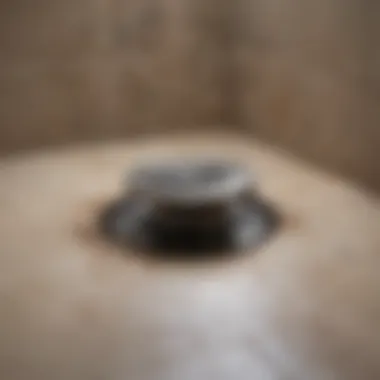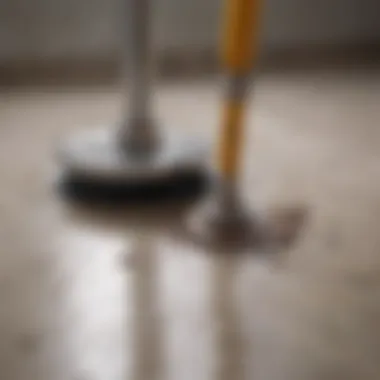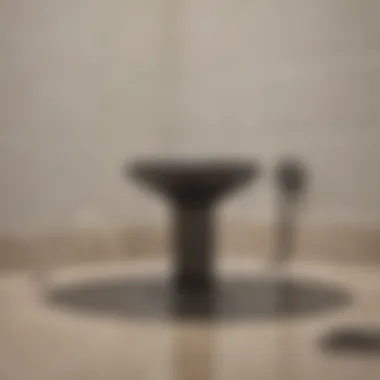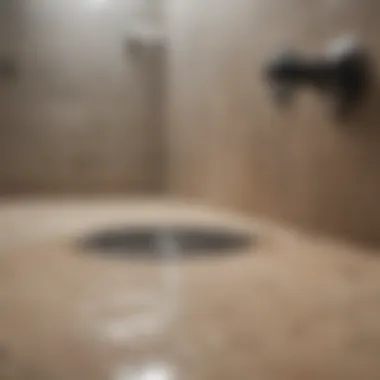Effective Strategies to Unclog Your Bathroom Shower Drain


Intro
A clogged shower drain is a common issue faced by many homeowners. The annoyance can disrupt daily routines and create unsanitary conditions. Understanding the reasons behind drain blockages can illuminate possible solutions. Furthermore, knowing the right tools and techniques can save time and money.
Regular maintenance plays a critical role in preventing clogs. With knowledge and a little effort, a blocked shower can quickly become a thing of the past. This guide aims to provide practical advice to efficiently resolve and prevent shower drain blockages, fostering an enjoyable bathing experience.
Design Inspiration
Clogged drains can be a result of poor design or the wrong choice of materials. Addressing potential design flaws can help homeowners avoid these issues in the future. Here are some useful insights.
Trending Styles
Modern shower designs often feature such elements as large tiles or minimalistic fixtures that can inadvertently impact drainage. Designers must consider the slope of the shower floor and the placement of drain openings. Adjusting these details can lead to more efficient water flow, decreasing the likelihood of clogs.
Color Palettes
When selecting fixtures and materials for the shower area, it's essential to choose not only aesthetically pleasing palettes but also those that facilitate easier maintenance. Darker colors tend to show dirt and hair more, leading to quicker recognition of blockages. Therefore, combining light hues with strategically placed darker elements can enhance both style and functionality.
Practical Tips
To overcome shower drain issues effectively, certain strategies should be employed. From maintenance to budgeting, every step can make a significant difference.
Maintenance & Care
Regular maintenance is crucial in preventing clogs. Consider these practices:
- Hair Traps: Use a hair catcher to minimize hair entering the drain.
- Weekly Cleaning: Pour hot water down the drain every week to reduce build-up.
- Natural Cleaners: Utilize a mix of vinegar and baking soda monthly to dissolve minor clogs.
Budgeting & Planning
Dealing with a clogged drain can be expensive, yet proper planning can mitigate costs. Set aside a small budget for:
- Maintenance Products: Invest in cleaning supplies that prevent clogs.
- Tools: Purchase a plunger or auger for quick, DIY solutions.
- Professional Help: Establish a connection with a reliable plumber for emergencies.
"Regular upkeep on your home’s plumbing is not only prudent; it saves money in the long run."
Understanding these design aspects and maintenance tips can significantly reduce the headaches associated with clogged drains, ensuring a smooth flow in your daily routine.
Prolusion
Clogged shower drains represent a common yet significant inconvenience for homeowners. Understanding the effective strategies to unclog these drains can save time and reduce frustration. Maintaining a functioning shower drain ensures a comfortable bathing experience and prevents potential water damage to the bathroom.
A clogged drain can lead to an array of problems, including unpleasant odors and unsightly water pooling. Regularly addressing blockage issues can extend the life of plumbing systems and reduce the need for costly repairs. Moreover, the process of unclogging can be straightforward with the right knowledge and tools.
This article aims to equip homeowners, interior design enthusiasts, and anyone concerned with their living space's functionality with an insightful guide on how to manage and prevent shower drain clogs effectively. It will explore various causes of clogs, the useful tools and techniques for removal, and preventive measures to ensure optimal drainage. By grasping these elements, readers can create a more pleasant and functional bathing environment.
"Effective maintenance of your shower drain not only improves hygiene but also enhances overall bathroom aesthetics."
Being proactive about drain care can spare homeowners from the stress of unexpected plumbing issues, making this topic highly relevant for those who value their living spaces.
Understanding the Common Causes of Shower Drain Clogs
Recognizing the underlying causes of shower drain clogs is essential for proper maintenance and prevention. Knowledge in this area arms homeowners with the insight needed to tackle blockages before they escalate, which can save time and money in the long run. Familiarity with what leads to clogs aids in selecting the right cleaning tools and methods.
Hair Accumulation


Hair buildup is often the primary contributor to clogged shower drains. As we shower, loose strands fall and combine with soap scum and other particles. Many people may not realize that even a small amount of hair can lead to a blockage over time. Routine cleaning or installing a drain cover can significantly reduce hair’s accumulation in the pipes. Keeping the hair off of the floor during showers even helps, as it can prevent excessive shedding. Regularly pulling hair from the drain cover also ensures that the water flows freely.
Soap Scum Buildup
Soap scum is another major factor resulting in blocked drains. The byproducts of soap and body wash cling to the sides of pipes. Over time, a thick grungy residue forms, narrowing the passage for water. This process is often unnoticed until drainage becomes slow. Using a liquid cleaner specifically designed to break down soap buildup can assist in keeping drains clear. Additionally, opting for bar soaps that contain fewer additives can create less buildup over time.
Foreign Objects
Foreign objects can find their way into shower drains, like small toys, pieces of clothing, or other debris. These unexpected items can lodge in the pipeline, leading to a clog. Awareness makes a significant difference. It is vital to ensure that nothing unintended ends up in the drain. Utilizing a mesh shower drain cover may effectively prevent foreign items from entering the drain system.
Pipe Corrosion
Pipe corrosion is a problem that can develop gradually, especially in older homes. Corroding pipes create rough surfaces and debris that contribute to drainage issues. Metal pipes, for example, are more susceptible to this issue, often creating rust and sediment in the drains. If corrosion is a concern, it is advisable to seek the help of a plumbing professional to evaluate the state of your pipes and suggest suitable replacements when necessary.
Tools and Materials for Unclogging
Having the right tools and materials is essential for effectively unclogging a shower drain. The effectiveness of your cleaning efforts largely depends on the tools you choose to employ, as each one serves a specific purpose and method of action. Choosing the wrong tool can lead to ineffective results, frustration, and potential damage to your plumbing.
Using appropriate tools can make the process quicker and easier. Understanding the specifics of each tool will help you know when and how to use it efficiently. Factors to consider include the severity of the clog, the accessibility of the drain, and your comfort level with DIY plumbing tasks.
Plunger
A plunger is a basic yet critical tool for unclogging shower drains. It works by creating a vacuum that pulls out the blockage. When using a plunger, ensure that you create a tight seal over the drain. Plungers are quite affordable and can be found in most home improvement stores.
It is essential to choose the right type of plunger; a flat-headed plunger is more suitable for sinks, while a cup plunger works better for shower drains. Apply a few vigorous thrusts and check if the water begins to drain away. If not, you may need to combine this tool with others for more stubborn clogs.
Drain Snake
A drain snake, or auger, is a more advanced tool designed for serious clogs. This tool consists of a long, flexible metal coil that can reach deeper into pipes. It can break apart tough clogs that a plunger cannot handle, such as hair bundles or solid obstructions. To use it, insert the snake into the drain until you feel resistance, then twist it to grab or break the clog.
Drain snakes come in manual and powered variations. A manual snake is easier for most homeowners to handle, while powered snakes may be better suited for severe or frequent clogging.
Wet/Dry Vacuum
A wet/dry vacuum is another effective tool for removing clogs, especially if the blockage is liquid-based or a substantial buildup. To utilize this tool, set it to liquid suction mode and ensure the filter is appropriate for wet applications. Position the vacuum hose at the drain, creating a tight seal. This method can remove excess water and pull out some clogs effectively. However, caution is necessary with electric equipment around water.
Chemical Drain Cleaners
Chemical drain cleaners provide an alternative for unclogging when mechanical methods fail. These products work by using particular chemical reactions to dissolve clogs. However, they should be used sparingly and with caution.
There are mainly two types: those that use strong acids or alkaline compounds, and enzymatic cleaners that are more sustainable. Before using a chemical cleaner, read the label carefully and follow the instructions. It is vital not to mix different types of cleaners, as it can create hazardous reactions.
Step-by-Step Guide to Unclogging a Shower Drain
A methodical approach to draining clogged shower issues can save time and prevent further complications in the long run. The Step-by-Step Guide ensures you have clear directions to tackle the problem efficiently. From identifying underlying problems to applying specific techniques, these steps can help maintain a functional bathroom environment while minimizing damage to the plumbing system. Each step is relevant as they each address distinct aspects of the clogging situation, allowing for tailored interventions.
Preparation
Before you begin, it is essential to prepare adequately. Gather all necessary tools and materials to avoid interruptions once you start. This preparation phase includes:
- Gathering Tools: Take the time to ensure you have your plunger, drain snake, wet/dry vacuum, and chemical cleaners on hand. Using the right tool increases your chances of successfully resolving the clog.
- Clearing the Area: Remove any rugs or items from around the shower. This not only protects your belongings but also provides unrestricted access to the drain.
- Wearing Protective Gear: Gloves are a must. This protects your hands from grime and potentially harmful substances. Consider wearing goggles to shield your eyes if you are using chemical cleaners.
Being thoroughly prepared is vital. This phase sets the tone for the effectiveness of subsequent efforts and ensures you can proceed without distractions.
Using a Plunger
A plunger is often the first tool to reach for in case of shower drain clogs. Its mechanical action can dislodge minor blockages effectively. To use a plunger:


- Position the plunger over the drain, ensuring a good seal. If there’s excess water, remove some of it until you can cover the drain entirely.
- Apply firm, steady pressure, followed by quick pulls to create suction. Repeat this motion for about 30 seconds.
- Check if the water begins to drain. If successful, clean the drain area to prevent future issues.
Employing a plunger is generally straightforward and requires minimal tools. For light clogs, it can be remarkably effective. However, remember that it may not work for more severe blockages.
Employing a Drain Snake
A drain snake is another invaluable asset in the fight against clogged drains. It reaches deeper into the pipes, which often yields results if the clog is caused by hair or other debris. Here’s how to use it:
- Insert the snake into the drain until you feel resistance.
- Rotate the snake handle to catch the blockage and pull it out.
- Continue feeding the snake into the drain until you feel the obstruction clear.
This method may require practice. The risk of damaging pipes increases if too much force is applied. Therefore, it is advisable to be gentle and patient.
Applying a Wet/Dry Vacuum
A wet/dry vacuum can be effective for stubborn clogs, especially when other methods fail. Using a vacuum allows for suction of large debris. For procedure:
- Ensure the vacuum is set to liquid mode.
- Create a tight seal at the drain, using the hose.
- Turn the vacuum on and let it suck the obstruction out.
Caution is warranted here. Make sure to use the vacuum correctly to avoid damage. This method can also help in situations where there is standing water.
Utilizing Chemical Cleaners
In cases of persistent blockages, chemical cleaners can provide a solution. These substances are designed to break down clogs effectively. To use chemical cleaners:
- Follow the manufacturer’s instructions carefully for the specified amount.
- Slowly pour the cleaner down the drain, avoiding splashes.
- Allow appropriate time for the cleaner to work, usually several hours or more, depending on the product.
This method, while effective, should be used as a last resort. Chemical cleaners can be harsh. Always ensure proper ventilation and wear protective gear when handling.
Taking these methodical steps will improve your chances of successful unclogging. Familiarizing yourself with these processes prepares you for handling common issues effectively.
Preventive Measures to Avoid Future Clogs
Preventive measures are essential in maintaining an unclogged bathroom shower drain. These proactive steps can save time, effort, and potential costs associated with plumbing issues. Understanding the importance of prevention is key. It not only enhances the longevity of your plumbing but also assures a pleasant shower experience.
Regular Cleaning
Incorporating a routine cleaning schedule is a fundamental aspect of prevention. Regular cleaning reduces buildup of hair, soap scum, and other debris that lead to clogs. A simple monthly cleaning can often suffice. Here are some tips for effective cleaning:
- Use a soft brush or cloth to scrub the drain cover and surrounding area.
- Flush with hot water to dissolve any soap residues.
- Consider vinegar and baking soda as a natural alternative. This combination can clear minor blockages and eliminate odors.
Setting aside time each month for cleaning helps maintain overall bathroom hygiene and keeps drains functioning smoothly.
Using Drain Screens
Installing drain screens can be a powerful line of defense against clogs. These inexpensive tools catch hair and larger debris, preventing them from entering the drain. When using drain screens:
- Select a screen that fits securely over your shower drain.
- Clean the screen regularly, ideally after each use. This step is crucial to avoid accumulation of debris on the screen itself.
- Choose a fine mesh to catch even the smallest hair strands.
By implementing drain screens, you drastically reduce the chances of encountering severe blockages in your plumbing system.
Avoiding Hair and Product Residue
Another effective preventive measure involves being mindful of what goes down the drain during daily routines. Hair is a notorious culprit when it comes to shower clogs. Here are practical strategies:
- Brush hair prior to showering to minimize loose strands entering the drain.
- Use liquid soap instead of bar soap when possible. Liquid soap tends to produce less residue.
- Rinse thoroughly after using any products. Shampoo, conditioner, and body wash can create build-up if not washed away completely.


Taking these preventative actions can lead to a significant decrease in the likelihood of clogs, resulting in less stress and inconvenience.
Regular upkeep and preventive measures can greatly extend the lifespan of your plumbing and enhance your overall bathing experience.
When to Seek Professional Help
Determining when to approach a professional for support with a clogged shower drain can be critical. Many homeowners might attempt to manage the clog themselves, but there are instances where professional intervention becomes necessary. Recognizing these situations can save time and prevent further damage.
Persistent Clogs
If you find yourself repeatedly facing clogs in your shower drain, it may be a signal that the problem is more severe than initial appearances suggest. A persistent clog can arise from deeper issues such as pipe blockages or severe buildup of materials.
In such cases, a professional plumber has the expertise to inspect the plumbing system thoroughly. They can identify any underlying causes that may not be easily detectable. Sometimes, DIY attempts may only provide temporary relief, while a plumber can diagnose and resolve the root cause effectively.
Signs of Pipe Damage
Pay attention to any signs of pipe damage, which can manifest in various ways. If you notice water leaks around the plumbing fixtures, persistent dampness, or increased mold growth in your bathroom, these may be indicators of pipe deterioration.
Professionals can assess the condition of the pipes with tools like cameras to provide a clear picture of any potential damages. Ignoring such issues can lead to more extensive repairs and higher expenses in the long run. Addressing pipe integrity is essential for maintaining a functional drainage system.
Health Hazards
Clogs not only disrupt daily routines but can also lead to health risks. Stagnant water in the shower can become a breeding ground for bacteria and mold, which can pose significant health hazards. If you detect unpleasant odors or notice changes in water drainage that indicate serious blockages, it is advisable to seek professional help promptly.
Dealing with potential mold or mildew can be particularly sensitive for those with respiratory conditions like asthma. A professional service can ensure that any hazardous materials are addressed and removed safely and thoroughly.
In summary, understanding when to seek professional assistance with a clogged shower drain can be crucial. Persistent issues, pipe damage, and health risks are key factors to consider, providing homeowners with a clearer path to effective solutions.
Epilogue
Moreover, knowing the right tools to use, like a drain snake or a plunger, ensures that you can act swiftly when clogs do occur. Preventive measures, which include regular cleaning and using drain screens, further mitigate the risk of future problems. These actions are not only beneficial for personal comfort but also contribute to the longevity of your plumbing system.
"Regular maintenance can save time and stress in the long run."
Lastly, understanding when to seek professional help adds another layer of smart decision-making. Persistent clogs or signs of pipe damage should not be ignored as they can lead to more serious and costly repairs. By synthesizing all this information, readers can take informed actions that lead to effective plumbing and a more enjoyable home experience. This article empowers homeowners and design enthusiasts alike to preserve their bathing spaces effectively.
DIY Maintenance Tips
Regular upkeep can make a significant difference in keeping your shower drain clear. Here are some useful practices:
- Routine Cleaning: Clean the drain cover and remove any visible debris at least once a month.
- Hot Water Flush: Pour boiling water down the drain periodically to dissolve soap scum and grease.
- Baking Soda and Vinegar: Use this classic combination monthly to freshenup and help with any build-up.
- Check Drain Screens: Ensure drain screens are in place to catch hair and larger particles.
Implementing these steps can extend the time between clogs and keep the drain functioning well.
Professional Services
Despite best efforts at DIY maintenance, there are times when professional help is necessary. It is advisable to consult experts in specific situations:
- Complex Clogs: When multiple attempts at unclogging fail, professionals have tools that can handle deeper blockages.
- Routine Inspections: Consider regular visits from a plumber to assess and maintain your plumbing system.
- Renovation Insights: If considering a bathroom renovation, consult professional plumbers for efficient layouts and advice.
Utilizing professional services can save time and prevent damage that might occur from improper handling of plumbing issues.
Plumbing Guidelines and Regulations
Familiarity with plumbing guidelines and regulations can prevent many issues before they arise. Here are several points to consider:
- Local Codes: Be aware of local plumbing codes and regulations, which govern materials and methods used.
- Material Choices: Use approved materials for repairs or installations, ensuring compliance and safety.
- Permits: Certain plumbing work may require permits. Always check if a permit is needed prior to starting renovations.
Adhering to guidelines and regulations can prevent costly fines and ensure that plumbing work meets safety requirements.
Using reliable resources not only empowers homeowners but also instills confidence in managing household plumbing effectively.
By arming oneself with pertinent knowledge, it becomes easier to tackle any potential issues that arise with shower drains.















